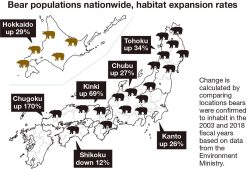
Umeo Koganemaru recalls sea-related childhood memories
10:00 JST, September 28, 2023
OJIKA, Nagasaki — Mushima Island has but a single inhabitant.
Along with 16 other small islands, the diminutive, remote landmass constitutes the town of Ojika in Nagasaki Prefecture.
Following his retirement, just over a decade ago, Umeo Koganemaru, now 74, returned to his depopulated hometown in hopes of helping revitalize the local community. Despite now being the island’s only occupant, he vows to stay on as long as he can.
I recently visited the island, which sits north of the Goto Islands in the prefecture, to speak with Koganemaru.
To reach the isle, I took an overnight ferry from Hakata Port in Fukuoka to Ojika Island, then transferred to the local government-operated, island-hopping Hamayu boat service. About 10 minutes into the journey, Mushima Island — known locally as “Whale Island” due to its cetaceous shape — hove into view.
Koganemaru greeted me with a smile at the local port, saying “Welcome to the island.”
On the island, which has a circumference of about 3 kilometers, Koganemaru grows vegetables and fruits, raises chickens and goats, and is a regular fisher. Waters around the reef-heavy land mass are crystal-clear and the seabed can easily be discerned. During the fishing season, Koganemaru dives for abalone and turban shells.
Driving off-road through overgrown paths, I saw houses and an elementary school gymnasium covered with thick ivy and other greenery; the phrase “Things always return to nature” floated into my mind.
Koganemaru lives in the house where his younger brother had lived before leaving the island. The domicile is supplied with gas and electricity, and has access to well water and mobile broadband.
Koganemaru, who visits the town’s main island (Ojika Island) several times a month to deliver fish to the local fishing cooperative, funds his lifestyle from personal saving but says that his main expenses tend to be for utilities, seedlings, fertilizers and boat fuel.
“Home is where you make it,” he said.

Mushima island, is also known as “Whale Island”
Agriculture teacher
After graduating from high school, Koganemaru left the island, thinking he would likely never return. As the eldest son of a farming family, he had been expected to take over the family business, according to prevailing customs of the time.
However, he says he was inspired to strike out for new pastures after borrowing Jules Verne’s “Two Years’ Vacation” and Mark Twain’s “The Adventures of Tom Sawyer” from the school library.
Also, Koganemaru learned that many young Americans participated in international cooperation in developing countries, and he began to think that he, too, could help out by leveraging his farming skills.
His parents supported his decision to leave the island, saying he should follow his heart. Koganemaru subsequently studied at the Tokyo University of Agriculture and trained in dairy farming in the United States.
After joining the Japan International Cooperation Agency (JICA), he was posted to more than 10 countries in South America, the Middle East and Africa. After leaving the JICA, he worked as a volunteer in Bolivia for two years as an agricultural instructor.
During his working years, Koganemaru occasionally returned to his home-town, and on each occasion, became increasingly aware that the local population was in decline. Severe damage inflicted by a typhoon in 1987 exacerbated the depopulation trend.
“Eventually it will become an uninhabited island,” he said. “But I didn’t want to let that happen easily.” He felt he owed something to the island where he had nurtured his dream, which helped him travel around the world. Decades later, he wanted to give something back to the island.
In January 2013, he left his wife in Chiba Prefecture and returned to the island alone. At the time, only around a dozen people lived on the island, far fewer than the about 240 people who lived there when Koganemaru first moved to Tokyo.
Koganemaru showed me around his farmland in a mini truck. In addition to watermelons, basil, cucumbers and sweet potatoes, he also grows seitakayoshi, a tall reed-like plant that helps divide the land and shield it from winds. Koganemaru told me he had also successfully grown guavas and mikan tangerines.
After first moving back to the island, he used his experience in teaching agriculture overseas with the aim of introducing agritourism as a tourism resource, along with a minpaku lodging system and other measures aimed at revitalizing the island.
However, Koganemaru said he also became aware that remote islands have many disadvantages. Although he tried to fund such activities from his own pocket, he quickly realized that the cost of transporting materials was surprisingly high.
He tried to raise cash via crowdfunding, but failed to reach his hoped-for target. Compounding his difficulties, the local authorities were reticent to allocate funds to promote an almost uninhabited isle.
Koganemaru had hoped that others would join him in his efforts if he continued working hard, but extra support never appeared. Several years ago, two relatives left the island, leaving him as the sole resident.
Now, Koganemaru says he cautions tourists against visiting the island due to a lack of familiarity with the environment, which could result in becoming lost or being attacked by wild boars — potential incidents that he is not equipped to deal with.

Left: Goats owned by Koganemaru
Right: Koganemaru harvests cucumbers
Island feast
Koganemaru spends several hours each day working his land. At other times, he catches up with domestic and overseas news, and watches videos on his smartphone.
Though still in good health, he says he is aware that his physical strength is declining. Recently, he has been reticent about sailing when the waves are even slightly larger than usual.
Old friends and former colleagues visit Koganemaru several times a year, and he treats them to local delicacies such as freshly laid eggs and goat’s-milk yogurt. He also sends locally caught seafood to acquaintances as gifts.
Koganemaru says he is always happy when the island’s produce is praised for its tastiness. Looking ahead, he hopes to welcome his young grandchild to the island in the near future.
Shigemi Kawano, 70, an acquaintance of Koganemaru who works mainly as a yacht attendant in Sasebo in the prefecture, occasionally visits the island to sail or fish, and the two often dine together on such occasions.
Koganemaru says he is concerned about possible damage to buildings and his farmland due to harsh weather.
Luckily for me, however, the weather was calm when I visited. While waiting for the boat for my return trip, I listened to the waves lapping rhythmically against the sides of a moored fishing boat.
“Revitalizing the island is beyond my power,” Koganemaru said. “For the past three years, I couldn’t work much due to the effects of the novel coronavirus pandemic. I want to stay here as long as I can, before finally saying ‘goodbye’ to the island that will then become uninhabited, and return to my wife.”

Koganemaru, left, fishes while talking with Shigemi Kawano, who sometimes visits the island.
‘500 communities to disappear’
The nation’s population continues to decline. According to central government surveys conducted through interviews with depopulated areas and remote islands in fiscal 2019, 505 communities said they expect “to disappear within a decade,” while 3,117 communities said they “will disappear sooner or later.”
The polls were conducted by the Land, Infrastructure, Transport and Tourism Ministry; and the Internal Affairs and Communications Ministry, primarily via local governments.
"JN Specialities" POPULAR ARTICLE
-

English-language Kabuki, Kyogen Entertain Audiences in Tokyo; Portland State University Professor Emeritus, Graduates Perform
-

Noodle Dining Shunsai / Rich Oyster Ramen to Savor at Odasaga; Experienced 68-year-old Owner Creates Numerous Ramen Varieties
-

Yomiuri International Cooperation Prize: Prize fosters future generations of professionals
-

The Japan News / Weekly Edition (12/5-12/11)
-

People Keep Loved Ones’ Ashes Close in Special Jewelry, Small Urns as Unique Way to Memorialize Them
JN ACCESS RANKING
-

Japan’s Hopes for Seafood Exports Shot Down in China Spat
-

Essential Services Shortage to Hit Japan’s GDP By Up to ¥76 Tril. By 2040
-

Japan to Charge Foreigners More for Residence Permits, Looking to Align with Western Countries
-

Japan Exports Rise in October as Slump in U.S. Sales Eases
-

Japan GDP Down Annualized 1.8% in July-Sept.





















